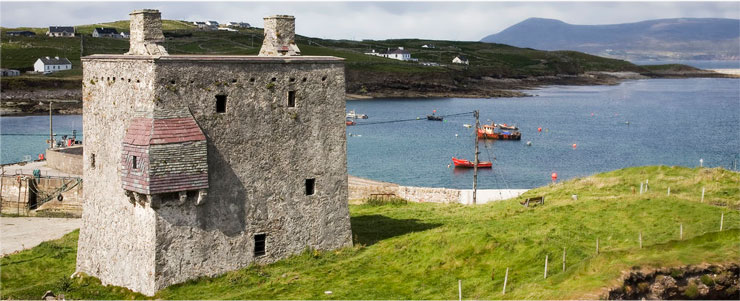Clew Bay Archeological Trail

Stage 4 Clare Island, Oilean Cliara
The Clare Island section includes 5 sites:
CLARE ISLAND TOWER HOUSE
Clare Island castle is a fine example of Tower House and dominates over the main harbour of the island. It was built by the O’Malley in the 16th century and was strategically located as a sentinel over Clew Bay.
Tower Houses were buildings erected by the ruling Irish Chieftains. They used as fortified residence and were common in this area (Kildamhnait Castle on Achill Island and Rockfleet Castle near Newport). Rectangular shaped they had three storeys with a vault over the ground floor and a pitched slate or thatched roof.
Inside the castle, to the left of the main entrance, are the stone stairs beginning at the first floor, wooden stairs from the ground floor led to these stairs.
The main living room was at first level floor and within the thick walls were passages and lavatories. Around 1826 the Tower was changed into a police barracks.
CLARE ISLAND ABBEY, KILL
Clare Island has an important cultural heritage including the ruins of a little Abbey founded by Cistercians in 1224.
The Abbey (rebuilt around 1460) consists of a little nave and a chancel divided by an arch. It is known for its rare medieval paintings recognised as among the most important examples in Ireland.
The paintings on the walls and ceilings give a glimpse of medieval life and depict a cattle raid, a knight dressed in chain mail on horseback, wolves attacking stags, musicians, dragons and griffins.
The Abbey also contains the O'Malley Tomb, a possible burial site of Gráinne O'Malley. It is a grey canopied tomb originally painted in red, white and black.
In the Abbey the O’Malley coat of arms can be seen; it shows the Motto of the O’Malley Clan: “Terra Marique Putens” (Valiant by sea and land).
THE SIGNAL TOWER, TOORMORE, TUAR MOR (THE BIG TOWER)
The ruins of a signal tower are located in Toormore at the most western point of Clare Island. The tower was built in 1804 in response to landings by the French in Ireland.
Signal towers played a central rule during the Napoleonic Wars (1803-1815) as stations of an early-19th-century communication and alert system along the coast. They were sited in remote locations and each station was visible to its counterparts on either side. These square shaped buildings had two storeys, a flat roof and fireplaces. A wooden ladder led to the main door usually built at first floor level.
The Clare Island Tower was linked to a tower on Achill Island to the North and to another tower on Inishturk to the South.
The signals included a large rectangular flag, a smaller blue pendant and four black balls in various combinations. The towers also communicated with ships.
The towers were abandoned after Napoleon’s defeat at Waterloo in 1815.
MEGALITHIC TOMB AND FULACHT FIADH AT PORTEEN FINOISH
Clare Island was inhabited by a farming community 5.500 years ago.
Excellent traces have been left at Porteen Finoish on the East side of the island. A megalithic court tomb can be found near a small lake. The site commands spectacular views on Clew Bay and Croagh Patrick.
Court tombs had an open-air court in front of the entrance to the tomb where funerary rituals and ceremonies took place. Also early fields walls and many Fulachta Fiadh can be seen in the area.
Fulachta Fiadh were Bronze Age open-air cooking sites used by island inhabitants. They were located near small springs and look like a grassy-covered horseshoe-shaped mounds. Stones were heated on a fire and dropped into a hole filled with water. The water was brought to boiling point by the stones and then meat, usually wrapped with straw, was lowered into the water to cook.
BRONZE AGE PROMONTORY FORT LECARROW, LETHCEATHRU, THE MIDDLE QUARTER
Clare Island boasts at least five Promontory Forts. They are located on the southern shore of the island and many can be seen walking along the roads.
Promontory Forts were built on top of headlands and cliffs from the late Bronze Age up to medieval time. They provided a formidable obstacle to attack and protected inhabitants from sea invasions. They were defended on three sides by the sea and on the landward by earth and stones.
These defensive structures are typical on the West coast of Ireland and suggest a separate building tradition and not an adaptation of the local hillfort type to a coastal situation.
